Mother’s milk: Indigenous Midwifery
Sophia Rosacker
“Mother’s Milk: Indigenous Midwifery” illustrates the connection between Native American women’s fight for reproductive justice and movements for indigenous sovereignty. The podcast highlights the systemic racism and cultural genocide facing Native Americans and shines a light particularly on indigenous practices of midwifery. The reteaching of these practices is very important for preserving Native American cultures and reclaiming autonomy under the colonialist U.S. government.
Trigger Warning: This podcast contains brief mention of sexual and physical abuse.
Full Transcript
Hello and welcome to my podcast, Mother’s Milk: Indigenous Midwifery. My name is Sophia Rosacker and I’d like to talk to you about the history of indigenous people’s reproductive rights and the revival of traditional indigenous practices of midwifery. We’ll be focusing particularly on the work of Mohawk midwife, environmentalist and indigenous rights activist Katsi Cook and the Mother’s Milk Project.
First, a little background information. For Native Americans, reproductive justice is inextricably tied to the fight for cultural preservation and restoration, land rights, and decolonization. To many indigenous cultures, women are the first environment and inseparable from the environment outside. The mother’s connection to the Earth and land is inherent, making her and her midwives an important intersection of feminism and sovereignty. Systemically, Native Americans have been subject to medical racism surrounding their rights to choose if they want to have children and if they do, their rights to parent their children and to be able to control their birthing options, such as midwifery.
According to Elizabeth Hoover in her article “Protecting Our Living Relatives: Environmental Reproductive Justice and Seed Rematriation,” “[r]eports surfaced in the 1970s that Indian Health Service clinics, which were tasked with providing health care for American Indian people, were sterilizing Native women without their informed consent as part of a campaign to reduce family size in populations seen as uncooperative and too reliant on the American government for services.” But as outlined in the book Undivided Rights: Women of Color Organize for Reproductive Justice by Jael Silliman, Marlene Gerber Fried, Loretta Ross, and Elena Guitiérriez, sterilization of indigenous people is just one weapon the U.S. government and medical system use to further ensure Native American genocide. The medical resources available to Native reservations are few and far between and those sanctioned by the government work more against Native populations than for them. Under the Indian Health Service (or IHS), Native Americans do not have the same rights to legal abortion as non-Native Americans have under Medicaid because IHS abides by the Hyde Amendment, which restricts federal funding for abortions except in the cases of rape, incest or when the mother might die. Inability to afford legal abortion has led many Native Americans to turn to sterilization as an alternative. Federal funding for IHS centers in general is inadequate, providing a meager and limited defense against the adverse health effects of environmental pollution, high rates of unemployment, injection drug use, high rates of alcoholism, and lifetime trauma Native Americans are disproportionately prone to. Congress passed the Indian Healthcare Improvement Act in 1976, giving tribes the right to take control of IHS programs and facilities, but the estimated cost of federal funding for these facilities is still well above what they receive and Native Americans still continue to fight for their medical rights today.
From the middle of the 17th century up to now, Native American youth have been taken from their families and communities and placed in assimilationist boarding schools dedicated to indigenous cultural erasure, where they were punished for speaking their languages, forced to convert to Christianity, and were often subject to physical and sexual harassment. Many Native children were adopted by white parents or placed in the foster care system and grew up cut off from their communities and culture. Hoover says that “[i]n 1893, U.S. legislation prohibited the removal of Native American children to off-reservation schools without the full consent of their parents,” although whether the consent of parents whose children continue to be placed in boarding schools is given willingly is questionable. And the authors of Undivided Rights say that in 1978, Congress passed the Indian Child Welfare Act “and replaced jurisdiction over cases of foster care and adoption of Native children with tribal governments.” Nevertheless, many of these assimilationist schools still exist today and continue to enforce cultural erasure.
One way of preventing that erasure and restoring indigenous culture is through traditional practices of midwifery. Katsi Cook, a Mohawk elder and midwife, began several projects dedicated to women’s health and midwifery in the Mohawk Territory of Akwesasne. Most traditional midwives have died out or are too old to carry out the practices they know, but thanks in part to the work of Katsi Cook, traditional midwifery practices are being passed on to younger generations. Birth is traditionally centered around the care of the one giving birth, who will consult midwives for guidance, medicines, herbs and other techniques to ease the process. Midwives trained today carry the responsibility of learning their traditional practices, teaching them to others and monitoring the general health of their communities’ mothers, all without federal funding as indigenous, lay midwives.
Which brings us to the Mother’s Milk Project. The project was founded by Katsi Cook in 1985. Prospects for it began with concerns about PCBs from General Motors and local industries running into the St. Lawrence River, contaminating Akwesasne’s drinking water and in turn, having adverse effects on Akwesasne women’s breast milk. The authors of Undivided Rights say that the Mother’s Milk Project was created to “understand and characterize how toxic contaminants have moved through the local food chain, including mother’s milk.” The Mother’s Milk members trained themselves to be able to accurately interpret the results of breast milk samples to determine what chemicals were affecting Akwesasne women’s health. From their analyses, they found that the pollutants in the St. Lawrence River were making it into all parts of the food chain, from the fish to the wildlife and to the people. Traditionally, mothers are given fish to eat during pregnancy for their beneficial nutrients, which is pretty much out of the question for mothers at Akwesasne while the St. Lawrence is polluted and contaminates their breast milk. Working with the Inuit of Canada and Alaska, the Mother’s Milk Project helped establish the Six Nations Birthing Center, dedicated to raising greater awareness of the links between environmental degradation and reproductive health, aiding Native communities in birthing children using their cultural practices and traditions and making sure those children get to grow up with their culture. The Mother’s Milk Project continues to work today to give Native Americans the right to reproduce in safe and environmentally stable environments.
This has been Mother’s Milk: Indigenous Midwifery. Thank you for listening.
Bibliography
E-flux.com. “Protecting Our Living Relatives: Environmental Reproductive Justice and Seed Rematriation – Architecture – E-Flux,” 2017. https://www.e-flux.com/architecture/exhausted/379296/protecting-our-living-relatives-environmental-reproductive-justice-and-seed-rematriation/.
Silliman, Jael, Fried, Marlene Gerber, Ross, Loretta, and Gutiérrez , Elena. 2016. Undivided Rights : Women of Color Organizing for Reproductive Justice. Chicago: Haymarket Books. Accessed December 13, 2022. ProQuest Ebook Central.
In. “Proven Sustainable.” Proven Sustainable, January 12, 2021. https://provensustainable.org/blog/katsi-cook.


